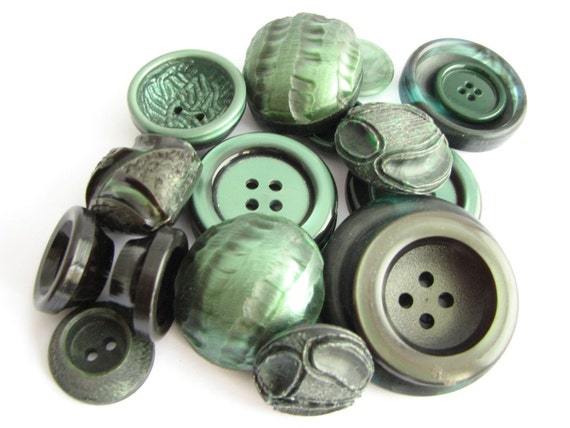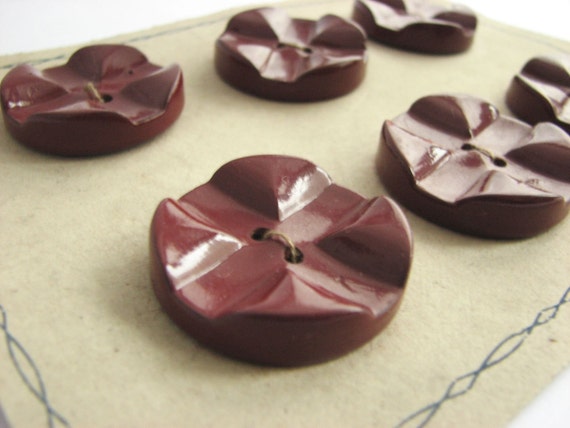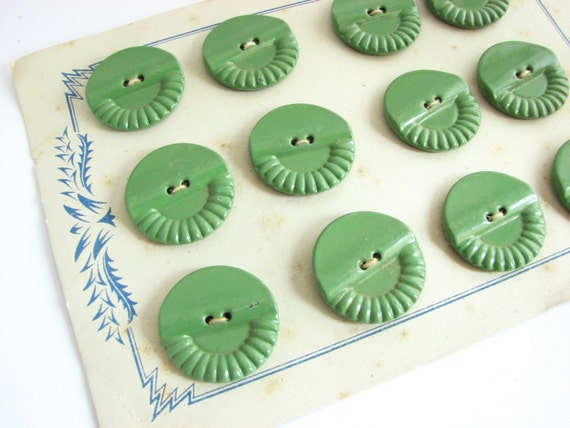Button identification is crucial to its dating. The state of the buttons can be misleading, as the colour can be very well preserved, and also, if unused, even brittle materials can last decades.
 |
| These buttons are from late 1950s - early 1960s. But these were easy to date, as I knew the exact time the shop that had acquired them was opened and closed. Actually, this was a very interesting time for the buttons. |
How to date buttons?
- In order to determine the age of the buttons, first you need to know what material they are made of. Is is mother of pearl? Casein? Bakelite? Or simply acrylic or nylon? Never use a hot needle for testing, as this will damage the piece and possibly even put you in danger, as some of the vintage plastics are highly inflammable. Here are some hints:
Identifying celluloid
Identifying Vegetable Ivory / Tagua nut buttons
Identifying Bakelite
Identifying Plexi glass
The difference between jet and black glass
Identifying mother of pearl
If your buttons are made of tagua nut and mother of pearl, they are probably dated 1920s - 1940s, though some manufacturers use this material to this day (though very, very rarely). Casein buttons were popular until 1950s, and so were celluloid buttons. They were substituted with modern plastics, which was more resistant to machine washing etc, along the 1950s and no longer produced.
Glass buttons are more difficult to identify this way because they have been produced for centuries and still are. The same for metal buttons. However, there are some clues to that too. And some glass looking buttons may have been made of jet, which only adds to their value.
The difference between jet and black glass
Identifying mother of pearl
If your buttons are made of tagua nut and mother of pearl, they are probably dated 1920s - 1940s, though some manufacturers use this material to this day (though very, very rarely). Casein buttons were popular until 1950s, and so were celluloid buttons. They were substituted with modern plastics, which was more resistant to machine washing etc, along the 1950s and no longer produced.
Glass buttons are more difficult to identify this way because they have been produced for centuries and still are. The same for metal buttons. However, there are some clues to that too. And some glass looking buttons may have been made of jet, which only adds to their value.
- The second most important thing is the style. Is it art deco? Or maybe your buttons are large Mod style from 1960s?
 |
| Art deco pieces usually feature geometric forms in strong contrast colours. Art deco pieces were popular until 1940s. |
 |
| Art Nouveau style usually imitates nature, and includes soft, curvy lines. These items are from early 20th century, up to 1930s. |
- The details can tell you more. Black glass buttons have different shanks and finish, depending on their age. The buttons from 1990s on can look perfectly old and stylish, but they usually have manufacturer's marks on the back. Be careful as black glass was also very popular in 1980s, when not everyone left their marks.
- Look at the back of the button. It may tell you a lot about the age and material.
 |
| This button has a very uneven surface, very characteristic for old casein buttons. |
 |
| Early plastics were not glued but rather drilled and screwed, like this wood and bakelite button. |
- There are also a few interesting facts about the world history that may help you identify the buttons. For example, in Europe during WW2, and in Spain, during and after the civil war (Spain was not involved directly in WW2) materials like plastic, a new invention, were scarce. Wooden and metal buttons were covered in thick layer of paint, usually in very vivid colours, to imitate plastic (however hard to believe this may seem). Also, the button cards were made of poor quality paper, like these buttons below:
 |
| You may find it hard to believe, but these buttons are made of wood. I scratched the layer of paint off one button of this kind to make sure. |
 |
| These buttons are made of metal, painted green to imitate plastic, although the paper card is much better quality. |
 |
| These buttons are made of plastic, but look at the card: its quality together with the design indicates that they are at least from 1940s. |




Do you have any advice as to where I can go to identify some unusual buttons?
ReplyDeleteIf you could send me photos of the front and back of the button I might be of some help. You may need to experiment a bit, but definitely NEVER use a hot needle to identify a button.
DeleteHi Agnes I'm out my field of any knowledge and was hoping for a tiny bit of assistants if thats Ok.
DeleteHello, thanks for the information on your site. I would like to know if you are still willing to help me identify some buttons?
ReplyDeleteThanks again, Lila
I was hoping you might be able to help me identify a pair of old buttons that I found while metal detecting. If you're willing /able to, I'd be grateful.
ReplyDeleteJack
I have some military buttons that look old and some metal ones that are small and even one with a golf ball with a crown on it how do I know I there old they look like black plastic
ReplyDeleteCan I send a photo of some buttons I have ?
ReplyDeleteI was curious if you might know the value.
Thank you
Lisa
I have old buttons attached with string to original cards. Brand is So Fro, made in Japan and packaged in Haiti. Any idea of age? The are mostly 4 hole shirt buttons
ReplyDeleteAre the cards printed? Send me some photos to my FB account, or IG and I will check!
DeleteI have old buttons attached with string to original cards. Brand is So Fro, made in Japan and packaged in Haiti. Any idea of age? The are mostly 4 hole shirt buttons
ReplyDeleteI worked at So Fro fabrics. They were originally part of Red Owl, Gambles company and called House of Fabrics. The stores originated as House of Fabrics in the 1950's. In the late 70's, early 80's, they started replacing the old House of Fabric stores with So Fro in malls. The whole company went under shortly after 1985 and all stores were closed. Buyers from the company would purchase items from contacts they had for the departments they worked in. I know they traveled extensively, it wouldn't surprise me if the buttons were purchased at a trade show in California.
DeleteHi! I just bought a large amount of La Mode buttons on cards. They have numbers on the back that look like it would be easy to date them. But I can't find a site anywhere with this. Same for other full button cards in the mis, like La Petite.
ReplyDeleteI would greatly appreciate any help here!
Hi i have some old buttons i wondered if you could help identify what they are they have like a faint line across the backrunning through the eye and a makers mark and on the front they have letters uvc but the v is like roman numerals and some other small marks and 1780 at the bottom thanks
ReplyDeletePhill , manchester uk
I need some help getting to know what buttons I have have value and which dont don't
ReplyDeleteThis has been a very helpful site to help me identify my buttons. Plenty of visual examples and descriptions. Thank you
ReplyDeleteI found a metal button ,two holes and it says JM $ co on one side and Atlanta Ga on the other. Help me identify it please
ReplyDelete